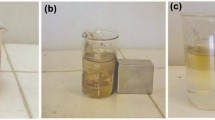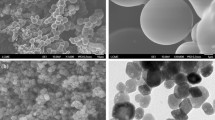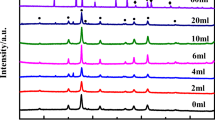Abstract
A facile approach was used for synthesize size-controlled monodisperse magnetite (Fe3O4) nanoparticles. In this method, precursors were obtained only using iron (III) chloride though a simple non-alkoxide sol–gel method. Meanwhile, this operation is without the need for inert gas atmosphere and refluxing conditions and without the strict control of high temperature and pressure. The phase structures, morphologies, particle sizes and magnetic properties of Fe3O4 nanoparticles were characterized by X-ray diffraction, transmission electron diffraction, fourier-transform infrared spectroscopy, near-edge X-ray absorption fine structure and vibrating sample magnetometer. Although this approach is a small modification to other methods, the synthetic pathway includes the advantages of several other methods. In addition, this method may offer a feasible strategy for those reaction which need more moderate reaction conditions.





Similar content being viewed by others
References
Tian Y, Yu B, Li X et al (2011) Facile solvothermal synthesis of monodisperse Fe3O4 nanocrystals with precise size control of one nanometre as potential MRI contrast agents. J Mater Chem 21:2476–2481
Deng YH, Qi DW, Deng CH et al (2007) Superparamagnetic high-magnetization microspheres with an Fe3O4@SiO2 core and perpendicularly aligned mesoporous SiO2 shell for removal of microcystins. J Am Soc 130:28–29
Deng H, Li XL, Peng Q et al (2005) Monodisperse magnetic single-crystal ferrite microspheres. Angew Chem Int Ed 44:2782–2785
Park J, An J, Hwang Y et al (2004) Ultra-large-scale syntheses of monodisperse nanocrystals. Nat Mat 3:891–895
Ge JP, Hu YG, Biasini M et al (2007) Superparamagnetic magnetite colloidal nanocrystal clusters. Science 46:4342–4345
Tsuzuki T, Schäffel T, Muroi M et al (2011) α-Fe2O3 Nano-platelets prepared by mechanochemical/thermal processing. Powder Technol 210:198–202
Zhou ZH, Wang J, Liu X et al (2001) Synthesis of Fe3O4 nanoparticles from emulsions. J Mater Chem 11:1704–1709
Lin CR, Chu YM, Wang SC (2006) Magnetic properties of magnetite nanoparticles prepared by mechanochemical reaction. Mater Lett 60:447–450
Fan R, Chen XH, Gui Z et al (2001) A new simple hydrothermal preparation of nanocrystalline magnetite Fe3O4. Mater Res Bull 36:497–502
Balasubramaniam C, Khollam YB, Banerjee I et al (2004) DC thermal arc-plasma preparation of nanometric and stoichiometric spherical magnetite(Fe3O4) powders. Mater Lett 58:3958–3962
Gash AE, Satcher JH, Simpson RL et al (2003) Use of epoxides in the Sol-Gel synthesis of porous iron(III) Oxide monoliths from Fe(III) salts. Chem Mater 15:3268
Long JW, Logan MS, Carpenter EE et al (2004) Synthesis and characterization of Mn–FeOx aerogels with magnetic properties. J Non-Cryst Solids 350:182–188
Qi HZ, Yan B, Lu W et al (2011) A Non-Alkoxide Sol-Gel Method for the Preparation of Magnetite (Fe3O4) Nanoparticles. Curr Nanosci 7:381–388
Sun SH, Zeng H, Robinson DB et al (2004) Monodisperse MFe2O4 (M = Fe Co., Mn) Nanoparticles. J Am Chem Soc 126:273–279
Rockenberger J, Scher EC, Alivisatos AP (1999) A new nonhydrolytic single-precursor approach to surfactant-capped nanocrystals of transition metal oxides. J Am Chem Soc 121:11595–11596
Hyeon T, Lee SS, Park J et al (2001) Synthesis of highly crystalline and monodisperse maghemite nanocrystallites without a size-selection process. J Am Chem Soc 123:12798–12801
Qi HZ, Lu W, Li CK et al (2011) Synthesis and characterization of water-soluble magnetite nanocrystals via one-step sol-gel pathway. Sci China, Ser G 54:1239–1245
Li Z, Chen H, Bao H et al (2004) One-pot reaction to synthesize water-soluble magnetite nanocrystals. Chem Mater 16:1391–1393
Watzky MA, Finke RG (1997) Transition metal nanocluster formation kinetic and mechanistic studies. a new mechanism when hydrogen is the reductant: slow, continuous nucleation and fast autocatalytic surface growth. J Am Chem Soc 119:10382–10400
Klug HP, Alexander LE (1962) X-ray diffraction procedures for polycrystalline and amorphous materials. New York, Wiley, pp 491–538
Lopez-Quintela MA, Rivas J (1993) Chemical reaction in microemulsions: a powerful method to obtain ultra fine particles. J Colloid Inter Face Sci 158:446–451
Lee Y, Lee J, Bae CJ et al (2005) Large-scale synthesis of uniform and crystalline magnetite nanoparticles using reverse micelles as nanoreactors under reflux conditions. Adv Funct Mater 15:503–509
Li Z, Sun Q, Gao M (2005) Preparation of water-soluble magnetite nanocrystals from hydrated ferric salts in 2-pyrrolidone: mechanism leading to Fe3O4. Angew Chem Int Ed 44:123
Aslam M, Schultz EA, Sun T et al (2007) Synthesis of amine-stabilized aqueous colloidal iron oxide nanoparticles. Cryst Growth Des 7:471–475
Marcos RM, Heloise RB, Marcos RG et al (2013) Synthesis of highly hydrophilic magnetic nanoparticles of Fe3O4 for potential use in biologic systems. Colloid Surface A 417:224–229
Acknowledgments
The current investigations were financially supported by the Chinese National Science Foundation (Grant 50901052 and Grant 51071109),Projects of Shanghai Science and Technology Committee (10dz2211300), and Program for young Excellent Talents in Tongji University (2009KJ003). We thank the SSRF for the structure and chemical state measurements.
Author information
Authors and Affiliations
Corresponding author
Rights and permissions
About this article
Cite this article
Qi, H., Yan, B. & Lu, W. A facile synthetic pathway of monodisperse Fe3O4 nanocrystals. J Sol-Gel Sci Technol 69, 67–71 (2014). https://doi.org/10.1007/s10971-013-3187-2
Received:
Accepted:
Published:
Issue Date:
DOI: https://doi.org/10.1007/s10971-013-3187-2




